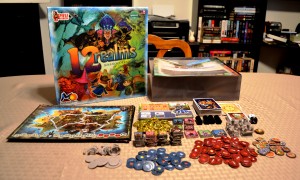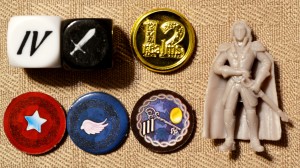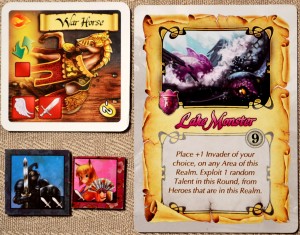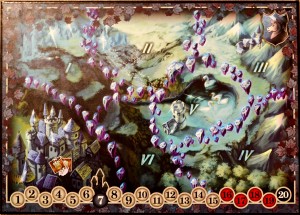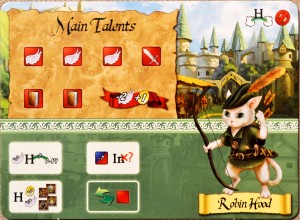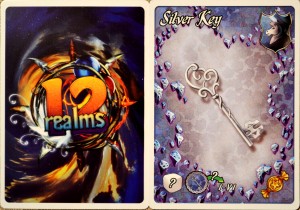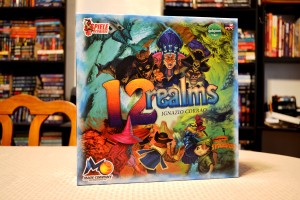Pop Quiz! What does Snow White, Red Riding Hood, Siegfried, and D’Artagnan have in common? Why, they all happen to be some of the heroes featured in the latest game published by MAGE Company…the same folks who brought you “Wrong Chemistry”. In “12 Realms”, players will take on the role of various heroes who must band together to stop the Lords of Darkness. It’s advertised as a fast and lighthearted cooperative experience, two qualities I always look for in the games I play. That begs the question: “How does it fare when the smoke finally clears?” Before I answer that, I’d like to thank the folks at MAGE Company and Game Salute for providing me with a free press copy.
Components
Realm Maps – These four separate maps serve as the board in which players will be moving around and attempting to thwart the Lords of Darkness. The number of maps used in a game depends on how many people are playing.
Hero Miniatures & Boards – Each hero in the game has a miniature and an accompanying board (similar to a hero/stat sheet). There are a total of eight heroes, each with unique skills and abilities.
Cards, Tokens, & Dice – There are way too many components under this category to mention, though I can sum it up by saying that each realm map has its own set of unique card/tokens to be used when playing the game. There are also talent tokens that are used by heroes to perform actions. Event cards mix things up a bit and gold coins serve as the currency for players to make use of during play. A black talent die and a white area die are also included to assist in the resolution of random events. There’s more, but I’ll save your sanity by stopping there.
Setup
There’s a bit involved with setting up the game, so I’ll simply opt to mention the highlights. First, players will need to decide how many realms to use. The more realms you have, the more difficult the game…though the number of players does factor into the difficulty as well. The realms that are going to be used for the game are “active” realms. Each realm has its own set of cards and tokens, so the “sleeping” realms and their respective components will be placed back in the box.
All of the Lord of Darkness cards from the active realms are revealed, with only one being chosen per realm…players will need to pay attention to the difficulty levels listed on the individual cards. Those that are chosen are placed near their respective realms, along with the appropriate realm tokens. The Lords of Darkness cards not chosen go back into the box. The rest of the active realm cards are shuffled into one large draw pile.
Each player chooses a hero and takes that hero’s miniature & board. The miniature is placed on any realm so as long as it starts in the town area. Players also receive enough red talent tokens to place onto their hero card, which track talents as they are used (exploited) and gained (refreshed). Town cards are shuffled separately into their own deck…these contain items that players can purchase during the game. Finally, the realms are populated with artifacts & treasures, with the invasion markers being placed near the invasion track situated at the bottom of the realm boards.
I included a link to the manual at the end of this article, should you wish more detailed information.
Gameplay
The game takes place over a series of turns, which are broken up into three phases: Invasion, Perform Actions, and Refresh.
Invasion – During the Invasion phase, the invasion marker on each realm is moved up by one for each invader currently on that realm (including the Lord of Darkness located there). Powers are then resolved appropriately. After that, two realm cards are drawn for each realm plus one extra, populating invaders and resolving artifacts/treasures as appropriate.
Perform Actions – In this phase, each player will take turns performing actions. This can involve moving, confronting an invader, claiming a treasure/artifact, trading, visiting town, and traveling. Some actions or situations involve the use of the talent tokens situated on a character card.
Refresh – Finally, the Refresh phase involves players refreshing (or making available) their exploited talent tokens.
This will continue until the game ends in either a collective victory or defeat. Players will be attempting to defeat every realm’s Lord of Darkness before any one invasion maker (on any of the realms) reaches “20”. The former results in victory, while the latter results in defeat.
The above doesn’t cover all of the rules found in the manual, but should give you a general idea as to how the game is played. For more information, please refer to the links at the end of this article.
The Review
Firstly, I need to commend the folks who designed and constructed the components used in the game. They are, without a doubt, highly detailed and beautiful to look at. My only gripe is that the hero minis came separated from their base, requiring the user to superglue them together. This may or may not be the standard when it comes to minis, but casual gamer families may not understand (or appreciate) the extra work. I thought that the art styles featured in each individual realm were superb and I liked how they each had their own “personality” if you will. The Cherry Blossom realm, for example, consisted of mainly reddish/pinkish hues while the Fairy Forest had a green colors associated with it. The realm cards were equally thematic, tying with their individual realms in easy to recognize ways. The manual was fairly detailed, but didn’t include a component listing…something I feel is standard in most games nowadays. With the number of components being on the high side, a components section would help newcomers significantly.
The learning curve was a bit on the steep side…not because of the gameplay itself, but because of all of the components that were included. I’m not complaining mind you, but it’s easy to imagine how the less initiated to board games could be intimidated by all of these pieces. The nice thing about “12 Realms” is that it’s fairly flexible. Players have control over how many realms they use, in addition to how many Lords of Darkness to include per realm. It’s relatively easy to make the game either very simple or very hard, depending on your threshold for pain. For an easier experience, use fewer realms and more players. If the latter isn’t possible, you could control more than one hero (keeping their character cards and inventory separate).
The cooperative experience is definitely a profound one in that players either sink or swim together, much like in “Pandemic”. I like the fact that players have the freedom to split up and cover more ground, or work together in the same realm and combat invaders together. The former strategy is favored a bit more, considering that all it takes to lose is one realm reaching its “20” on the invader track. The game also encourages cooperative play through trading, especially toward the latter half of the game. The Lord of Darkness over a particular realm will eventually show up, and players will need the required artifacts in order to challenge them. As such, players are encouraged to work together in order to meet these requirements.
If you are feeling the need to play competitively instead of cooperatively, there are a few different variants listed in the manual that might suit your fancy. “The Dark Player” variant, for example, controls all of the invaders and where they spawn (based on their affiliation). This dungeon master of sorts will be doing everything in his or her power to see that the Lords of Darkness succeed in their goal. Other variants simply exist to increase the difficulty a bit, for those of you who like a challenge. The “Black Fortress” variant uses…well…black fortress miniatures that are placed onto a realm when the invasion marker reaches “7+”. Invaders in said realm can’t be challenged until this black fortress is destroyed, which can potentially make the invasion marker run away from you if you don’t deal with that threat immediately.
In the end, “12 Realms” stands tall as a solid cooperative experience, backed by an impressive array of beautifully crafted components. Don’t let its cutesy nature fool you…there’s enough here to challenge even the most dedicated cooperative game fans. The art and gameplay mechanics are family-friendly, which is a bonus to game families with younger children. The learning curve and the price (currently $70.00 as of 11/21/13) may scare off casual gamer families, though I’m fairly confident that given time, they’d be able to conquer the former. This is one instance where it helps to have an experienced gamer in the family, as the manual does have a fair amount of detail. All in all, a wonderful game!
Final Verdict: 8/10
—
You can learn more about and purchase “12 Realms” by visiting the following websites:
http://magecompany.com/12realms.html
http://magecompany.com/rules/12reng.pdf

